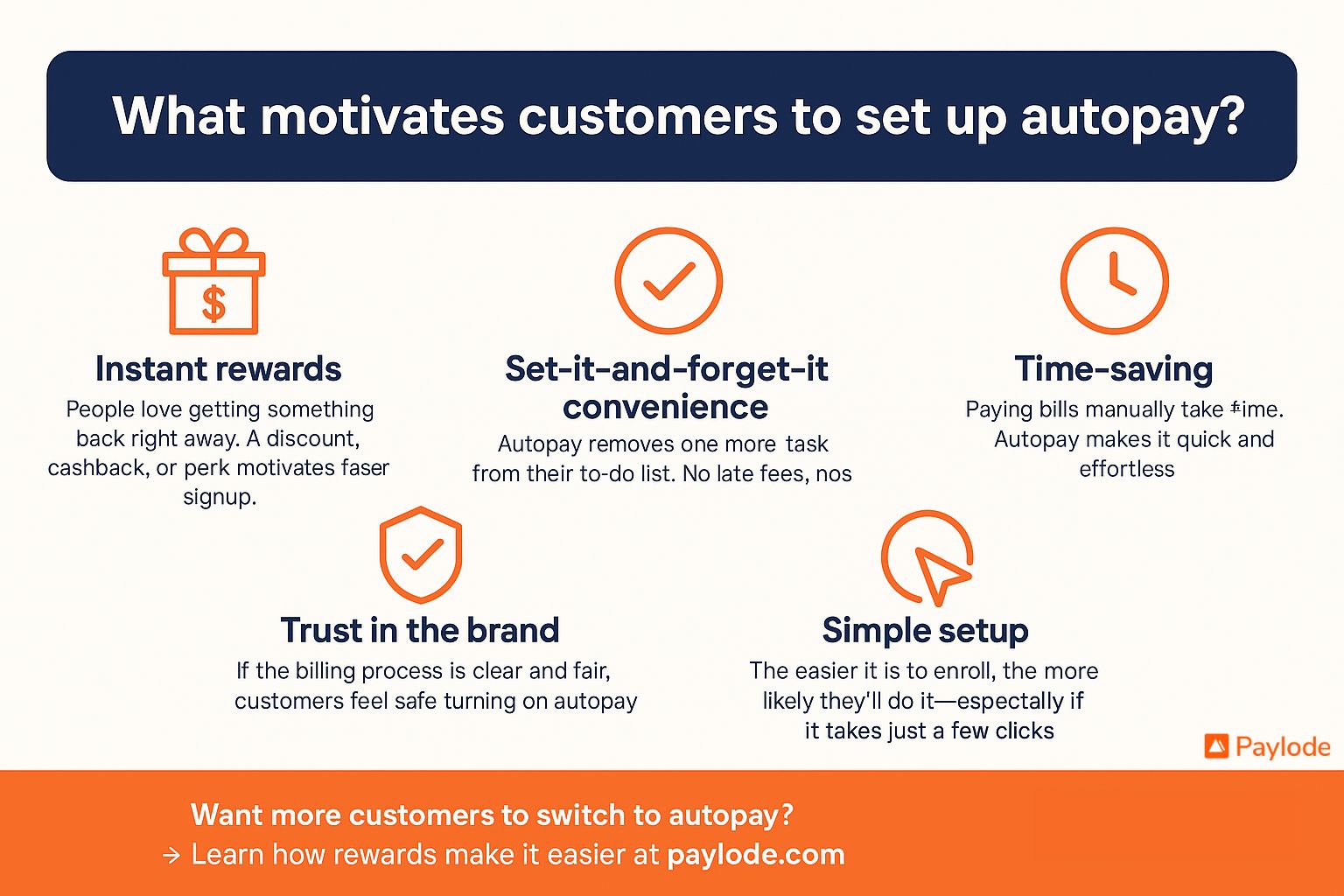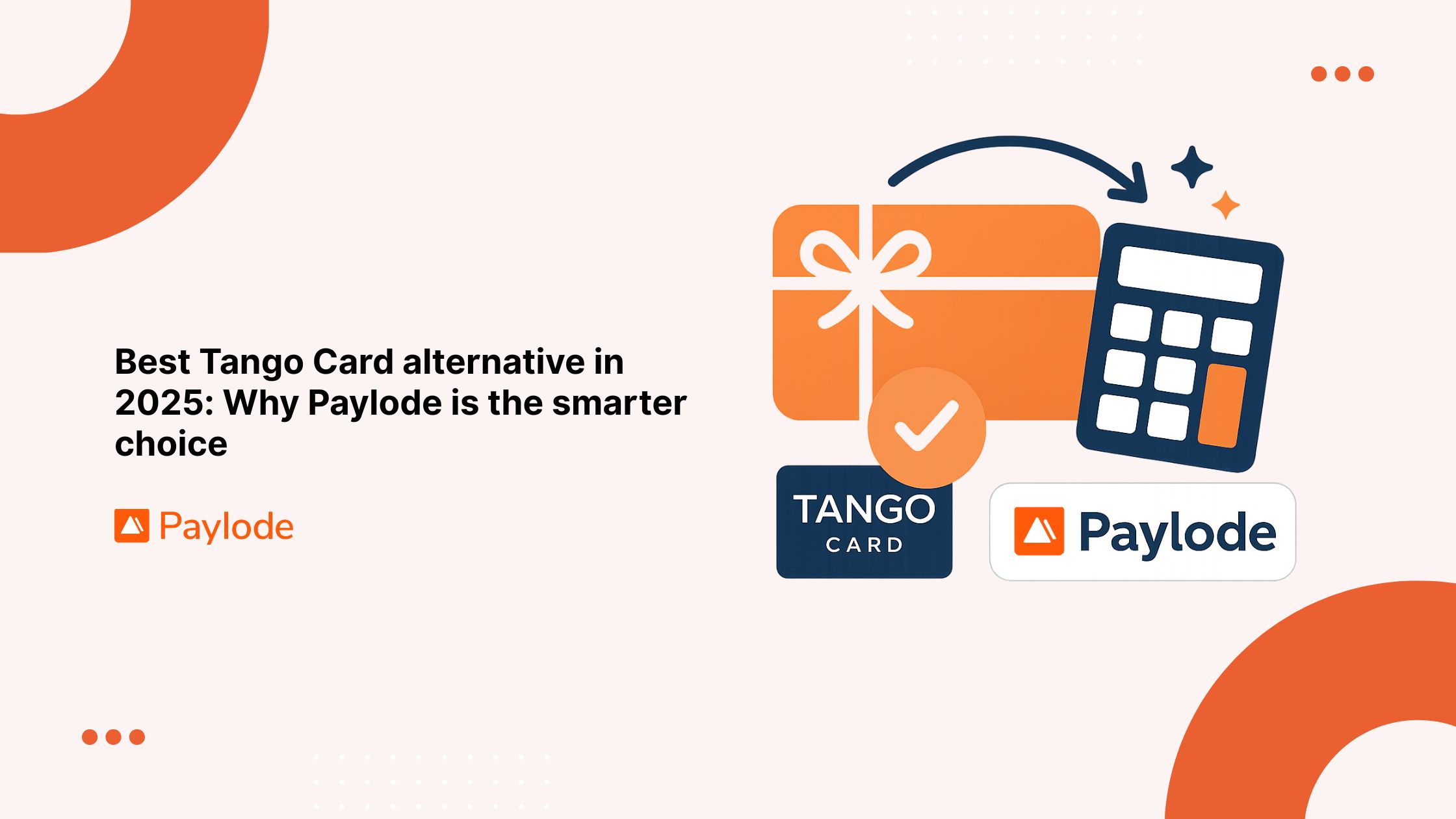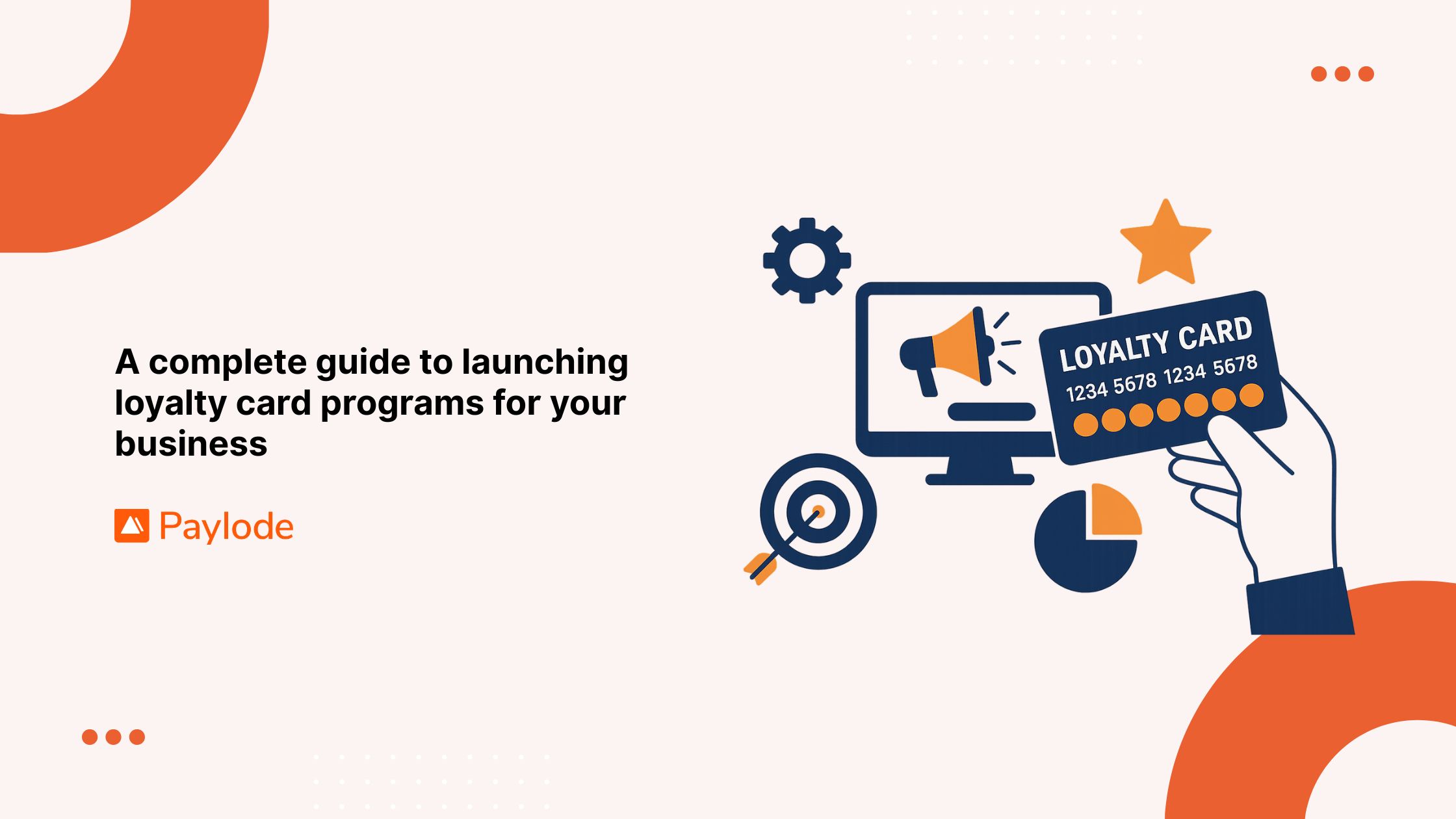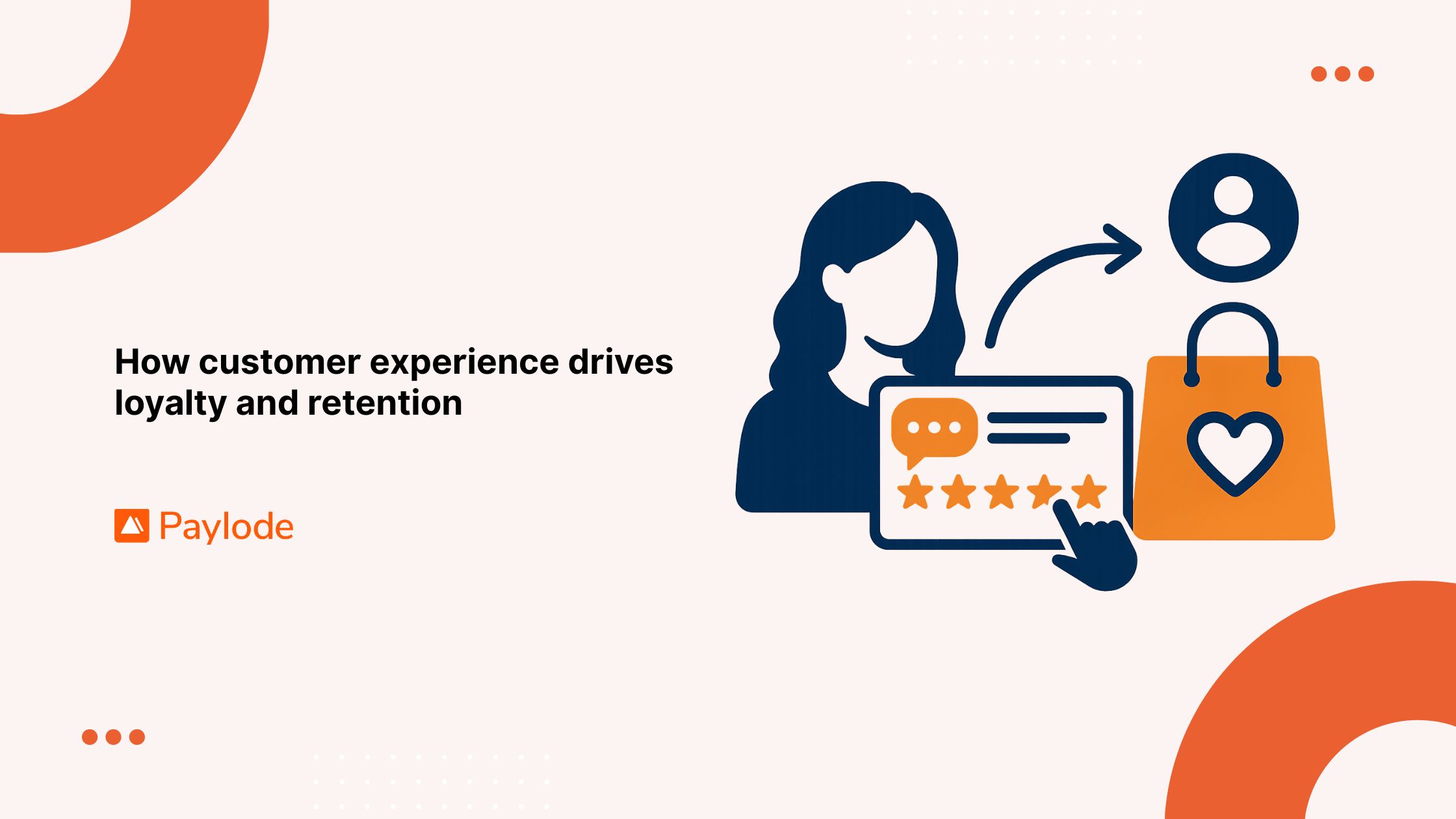When it comes to customer retention and payment compliance, offering the right incentives at the right moment can make all the difference. Traditional loyalty programs often rely on points systems or delayed benefits, but today’s consumers value immediacy and ease. This is where payment rewards — especially those tied to auto pay enrollment—play a powerful role.
By giving customers an instant reason to turn on automatic payments, brands are not just improving billing consistency—they're building trust, reducing churn, and increasing lifetime value. Whether it’s a digital perk, cashback, or a small lifestyle reward, these simple offers can shift behaviors quickly and meaningfully.
This blog explores how payment rewards improve both customer loyalty and auto pay rates, while keeping user experience front and center. We’ll also examine proven use cases, tools that simplify reward delivery, and ways to measure ROI effectively.
Ready to drive loyalty with seamless rewards? Explore our platform to see how Paylode makes it easy.
What makes a customer loyal in the digital billing era?
Customer loyalty today isn’t just about points or earning rewards over time—it’s about trust, ease, and instant value. In the digital billing era, where payments happen automatically and interactions are largely self-service, loyalty is measured less by long-term accumulation and more by consistent engagement and satisfaction.
So, what keeps customers coming back or staying committed to a brand when billing is involved?
It starts with reducing friction. If paying a bill feels effortless—and even better, rewarding—customers are more likely to stick with a service. Auto pay, in particular, is a key moment of behavioral commitment. When users turn it on, they’re saying, “I trust this service to bill me consistently and fairly.” That trust is the foundation of modern loyalty.
Next comes perceived value. Customers want to feel like their loyalty is recognized in real-time. Offering an instant digital perk or small reward for enabling auto pay reinforces that their behavior is appreciated—without making them wait.
Lastly, transparency and control matter. In an age of subscription fatigue and data sensitivity, giving users clarity around billing, payments, and the value they receive builds long-term retention.
In short, customer loyalty in today’s billing landscape is built through seamless experiences and timely, relevant incentives—not through points that expire or feel unattainable.
Want to make billing a loyalty driver? See how Perks from Paylode can help.
Why are traditional points-based systems losing their effectiveness?
Traditional loyalty programs—especially points-based systems—are losing their appeal in today’s fast-paced, digital-first world. While once seen as a gold standard for customer retention, these models now often fall short when it comes to real impact, especially in industries like banking, lending, and insurance.
One of the biggest issues is point breakage. Many users accumulate points but never redeem them—either because the process is too complicated or the rewards feel out of reach. This leads to frustration and reduces program trust.
There’s also a lack of immediacy. In a world of real-time everything—payments, notifications, and services—customers expect their rewards to arrive just as quickly. Waiting weeks or months to see the benefit of loyalty no longer feels relevant.
Additionally, points-based systems tend to be complex. With different tiers, expiration rules, and redemption portals, they create friction instead of delivering value. This is especially problematic in BFSI (banking, financial services, and insurance), where trust and simplicity are paramount.
Today’s customers are leaning toward instant, tangible rewards like digital gift cards, cashback, or lifestyle perks. These not only satisfy the need for immediacy but also drive behavior change—like setting up auto pay—much faster.
Points vs. instant rewards in BFSI: A quick comparison
By shifting from delayed loyalty to instant gratification, companies in financial services are seeing higher engagement and stronger customer retention.
👉 Explore how Boost helps deliver instant, personalized rewards that align with real billing behaviors.
How do instant rewards influence autopay decisions?
When it comes to changing customer behavior—especially around billing decisions like setting up autopay—timing is everything. Instant rewards tap into a powerful psychological trigger: the desire for immediate gratification. This concept, often summarized as “reward now, commit later,” is at the core of why instant incentives outperform delayed point systems.
Autopay setup can feel like a long-term commitment. Users often hesitate due to fear of losing control or being overcharged. But when a real, tangible reward—like a $10 digital gift card—is offered instantly after signing up, it reduces hesitation and reframes the action as a win.
This tactic also aids habit formation. Once users experience the ease and benefit of autopay, they’re more likely to stick with it. Over time, the friction of recurring payments disappears, replaced by the convenience and value of automation. Instant rewards help kick-start this behavior shift.
Real-world impact by industry:
- Fintech: A digital bank saw a 22% lift in autopay enrollment by replacing points with immediate cash-equivalent perks.
- Telecom: A leading MVNO reduced churn by 28% using reward-based engagement tied to autopay behavior. Read the case study.
- Real estate: Property managers who offered instant perks for rent autopay reported a measurable improvement in on-time payments and tenant satisfaction.
Incentives that align with customer intent—not just company goals—are the key to unlocking long-term loyalty through small, rewarding actions.

What are the top industries benefiting from payment-based rewards?
Not all industries approach billing the same way—but when it comes to driving consistent payments and loyalty, offering instant rewards is a proven strategy across multiple sectors. By aligning customer incentives with operational goals, brands are finding new ways to reduce friction and boost retention.
Here’s how some of the top industries are making the most of payment-based rewards:
Financial services
Credit card providers, digital banks, and BNPL platforms often struggle with late payments and account churn. Instant rewards for setting up autopay or making on-time payments have been shown to reduce delinquencies and encourage more consistent financial behavior. Unlike traditional point-based systems, instant perks are simple, transparent, and trusted by users—especially younger digital-native customers.
Explore how reward-based loyalty drives digital engagement
Telecom, ISPs & MVNOs
In a competitive space where customer churn is high, payment rewards boost billing reliability and retention. Whether it’s offering a $5 gift card for enabling autopay or rewarding paperless billing, telecom providers are seeing meaningful results. For instance, this MVNO cut churn by 28% using Paylode.
Residential real estate
Late rent payments create admin costs and stress for property managers. Offering instant perks for tenants who set up recurring rent payments makes the process smoother—and friendlier. This approach improves on-time rent rates while building goodwill.
Digital health
Health memberships, therapy apps, and medication subscriptions often suffer from drop-offs. By linking wellness perks or discounts to recurring billing behavior, digital health providers can drive both better financial outcomes and stronger patient adherence.
From finance to real estate, payment rewards aren’t just about loyalty—they’re a smart, measurable strategy for better billing and customer satisfaction.
How can brands personalize rewards to different user segments?
Not all customers respond to the same incentives. To make payment-based rewards truly effective, brands need to tailor the right offer to the right person at the right time. That’s where personalization becomes a powerful growth lever.
Start by segmenting your users:
- New users: Encourage behavior like setting up autopay or paperless billing with a welcome incentive.
- Churn-risk users: Win them back with targeted rewards triggered by inactivity or missed payments.
- Power users: Reward loyalty milestones or upsell premium services with exclusive perks.
Next, align rewards with contextual moments. For example:
- Offer a small gift card right before a due date to encourage timely payments.
- During onboarding, bundle actions like profile completion + autopay setup into one reward.
- Present incentives during product upgrade flows to increase average order value.
To streamline this approach, many brands use automation tools like Paylode’s Boost. Boost enables real-time reward delivery based on customer behavior, lifecycle stage, and engagement data. Whether it's sending a perk after a successful payment or nudging a user who hasn’t yet enrolled in autopay, Boost ensures that no opportunity is missed.
Personalized, timely rewards drive stronger user behavior and long-term loyalty—without adding manual overhead.
What happens when you bundle payment rewards with other actions?
Rewarding a single behavior like autopay enrollment is effective—but combining that with other key actions can multiply impact. When you bundle payment rewards with complementary behaviors, you create momentum across the customer journey and unlock higher engagement.
For instance, autopay + paperless billing is a natural pairing. When users are rewarded for choosing both, it increases operational efficiency and reduces costs. You also support sustainability efforts, which appeals to today’s environmentally-conscious customers. Learn how some brands have amplified adoption through our switch to a paperless use case.
During early onboarding, offering a reward for autopay + first login or profile setup can accelerate customer activation. Instead of waiting for engagement to build over time, you fast-track key behaviors up front. This approach is explored in more depth in our customer activation use case.
In residential real estate, combining rent autopay with resident perks—like local offers, digital memberships, or wellness rewards—boosts tenant satisfaction while ensuring predictable payments. This is highlighted in our resident perks use case.
By packaging incentives, brands improve campaign efficiency, elevate user satisfaction, and build stronger customer habits—all with fewer touchpoints. Bundled reward strategies create a win-win for users and businesses alike.
How do payment rewards strengthen trust and brand perception?
Trust is built when customers feel recognized, rewarded, and treated fairly. Payment rewards—especially instant, tangible ones—play a key role in shaping that perception. When users receive a benefit immediately after taking an action like enrolling in autopay, it creates a transparent value exchange. There’s no fine print or confusion, just clear cause and effect.
This immediacy improves satisfaction. Instead of waiting months to accumulate enough points for a vague future reward, users experience positive reinforcement in real time. This fosters stronger emotional connections with the brand and increases the likelihood of repeat engagement.
Moreover, these positive interactions reduce friction. Customers are less likely to contact support with questions about delayed points, expired perks, or missing rewards. Over time, that not only boosts efficiency but also improves Net Promoter Score (NPS) as users associate the brand with seamless, rewarding experiences.
In a digital-first world, simple and instant rewards do more than just drive behavior—they communicate reliability, appreciation, and alignment with customer needs.
What metrics should you track to measure success?
To evaluate the effectiveness of your payment rewards strategy, tracking the right metrics is critical. It’s not just about how many rewards you give out—but whether those rewards are driving meaningful business outcomes.
Start with the autopay enrollment rate. This is the clearest indicator that your incentive program is working to change user behavior. A spike in opt-ins after launching a rewards campaign signals strong alignment between the offer and user motivation.
Next, monitor churn reduction. Consistent, automated payments often correlate with lower customer turnover, especially in industries like telecom, fintech, and real estate. If your churn is dropping, it’s a sign that rewards are reinforcing retention.
Don’t overlook the reward redemption rate. This tells you how compelling and relevant your offers are. A high redemption rate usually means customers value the perk and understand the reward journey.
Finally, track the impact on customer lifetime value (LTV). If your users are sticking around longer, paying on time, and engaging more frequently, your LTV should climb—providing long-term ROI on short-term incentives.
Paylode makes it easy to track all of these KPIs with real-time dashboards and reporting tools, helping brands optimize performance and prove ROI.
How does Paylode make it easier to scale payment-based loyalty?
Scaling a payment rewards program across user segments, products, and billing systems can be complex—but with Paylode, it's built for simplicity and scale.
At the heart of Paylode’s solution is its perks engine—a flexible platform designed to automate reward delivery based on user actions like signing up for autopay, switching to paperless billing, or making on-time payments. These perks are instant, inventory-free, and proven to boost adoption without added operational burden.
Paylode enables segment-driven reward triggers, allowing you to target different user types with personalized incentives—whether they’re new, high-value, or at risk of churning. With automation built in, campaigns can run continuously without manual work.
Integration is also seamless. Paylode connects easily with your existing billing or CRM systems, ensuring rewards are triggered exactly when they should be. Whether it’s via APIs or no-code tools, implementation fits into your current workflows without disrupting them.
If your goal is to increase autopay enrollments, reduce friction, and create loyalty through better experiences, explore how Paylode powers results through its automatic payments use case.
What’s the smarter way to approach loyalty and payments?
In today’s digital billing world, loyalty isn’t about outdated point systems or delayed rewards—it’s about immediacy, ease, and relevance. Customers respond better to rewards they can use now, not later.
The smarter approach? Focus on real-time, contextual incentives that drive behavior—like setting up autopay, going paperless, or completing onboarding. These actions benefit your operations and create value for your customers at the same time.
With Paylode, brands are moving beyond the slow, manual methods of the past. They're adopting a loyalty system that’s fast, flexible, and designed to scale.
💡 Want to see how instant rewards can increase autopay, reduce churn, and improve customer lifetime value?
👉 Book a demo today and discover how Paylode can power your loyalty strategy.



